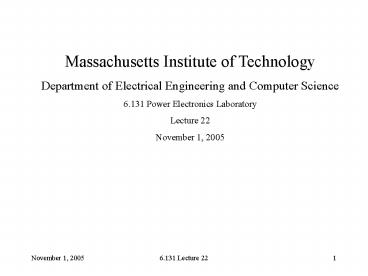Massachusetts Institute of Technology - PowerPoint PPT Presentation
Title:
Massachusetts Institute of Technology
Description:
Department of Electrical Engineering and Computer Science. 6.131 Power Electronics Laboratory ... Here is one way of switching that circuit: The arrows ... – PowerPoint PPT presentation
Number of Views:48
Avg rating:3.0/5.0
Title: Massachusetts Institute of Technology
1
Massachusetts Institute of Technology Department
of Electrical Engineering and Computer
Science 6.131 Power Electronics
Laboratory Lecture 22 November 1, 2005
2
Here is your basic three phase bridge
3
Suppose we have this situation
4
Here is one way of switching that circuit The
arrows designate when a switch is ON
5
Here is what is on in State 0
Va V, Vb V, Vc 0 Vn 2V/3
6
Here is what is on in State 1
Va 0, Vb V, Vc 0 Vn V/3
7
Here is what is on in State 2
Va 0, Vb V, Vc V Vn 2V/3
8
Here is what is on in State 3
Va 0, Vb 0, Vc V Vn V/3
9
Here is what is on in State 4
Va V, Vb 0, Vc V Vn 2V/3
10
Here is what is on in State 5
Va V, Vb 0, Vc 0 Vn V/3
11
Voltages Line-Line Voltages are well defined
12
- To generate switching signals
- Totem Pole A is High in states 0, 4 and 5
- Totem Pole B is High in states 0, 1 and 2
- Totem Pole C is High in states 2, 3 and 4
- This allows us to use very simple logic
- A S0 S4 S5
- B S0 S1 S2
- C S2 S3 S4
13
To generate switch signals Note that either top
or bottom switch is on in each phase Generation
of states we will do this a bit later (see below)
14
- This six pulse switching strategy
- Makes good use of the switching devices
- Also requires shoot-through delays
- Has very simple logic
- We propose an alternative switching strategy
- Makes minimally less effective use of switches
- Uses a little more logic
- But does not risk shoot through
15
Here is a comparison of switching strategies
180 degree six-pulse 120 degree six pulse Give
up a little timing between switch closings
16
Switches Q_1 and Q_5 are on State0
Va V, Vb 0, Vc V/2
17
Switches Q_1 and Q_6 are on State1
Va V, Vc 0, Vb V/2
18
Switches Q_2 and Q_6 are on State2
Vb V, Vc 0, Va V/2
19
Switches Q_2 and Q_4 are on State3
Va 0, Vb V, Vc V/2
20
Switches Q_3 and Q_4 are on State4
Va 0, Vc V, Vb V/2
21
Switches Q_3 and Q_5 are on State5
Vc V, Vb 0, Va V/2
22
This switching pattern results in these voltages
23
Switches turn on Q1 State_0 OR
State_1 Q2 State_2 OR State_3 Q3 State_4 OR
State_5 Q4 State_3 OR State_4 Q5 State_1 OR
State_5 Q6 State_1 OR State_2 Each switch is on
for two states
24
So here is how to do it 3 bit input to 138
selects one of 8 outputs Active low
output! 138 has 3 enable inputs two low, one
high
25
NAND (Not AND) Is the same as Negative Input OR
The 138 output is active low Matching
bubbles makes an OR function
26
Now we must generate six states in sequence If we
have a clock with rising edges at the right
time interval we can use a very simple finite
state machine This could be a counter, reset when
it sees 5
27
Here is a good counter to use 74LS163 This is a
loadable counter dont need that feature Clear
function is synchronous so it clears only ON a
clock edge Part is edge triggered changes
state on a positive clock edge P and T are
enables must pull them high
28
And here are the counter states note how CL works
29
We already detect state 5 with the 138
30
The 138 is a simple selector use like this
And here are the pinouts of the 163 and 138
31
Variable Voltage do the Pulse Width Modulation
thing
32
Why do we need to PWM only the top switches? What
happens with you turn OFF switch Q1?































